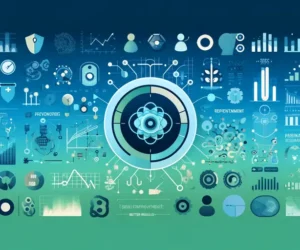
Advancing Beyond NLP

Natural Language Processing (NLP) has made significant strides in understanding and generating human language. However, advancements in machine learning and deep learning are pushing the boundaries of what is possible in language processing, enabling more sophisticated and nuanced interactions with text and speech.
- Machine Learning Algorithms in Language Processing
- Complex Language Structures and Nuances
- Enhanced Semantic Understanding
- Improved Language Generation
- Understanding Nuances and Context
- Natural Language Generation
- Neural Network Architectures for More Language Processing
- Develop Language Models
- Challenges of Multi-lingual Language Processing
- Future of Multi-lingual Language Processing
- What Are Knowledge Graphs?
- Why Integrate Knowledge Graphs With Language Processing Models?
- Benefits of Leveraging Knowledge Graphs
- Unlocking the Next Level of Language Processing
- How Does Reinforcement Learning Work for Language Processing Systems?
- Contextual Information in Language Processing
- Integrating World Knowledge into Language Processing
- Benefits of Pre-trained Language Models
- Popular Pre-trained Language Models
Machine Learning Algorithms in Language Processing
Machine learning algorithms in language processing are at the heart of many NLP applications. These algorithms analyze and learn from vast amounts of text data, enabling machines to understand, interpret, and generate human language. Popular algorithms include supervised learning models like logistic regression and support vector machines, as well as unsupervised learning methods such as clustering and topic modeling.
Deep learning has introduced powerful models like neural networks, which excel in handling complex language tasks. Recurrent Neural Networks (RNNs), Long Short-Term Memory (LSTM) networks, and Transformer architectures have revolutionized language processing, enabling more accurate and context-aware models. These advancements have led to significant improvements in machine translation, sentiment analysis, and text summarization.
Complex Language Structures and Nuances
Complex language structures and nuances present significant challenges for NLP. Human language is rich in idioms, metaphors, and cultural references, which can be difficult for machines to interpret accurately. Understanding context, tone, and implied meanings requires advanced models capable of deep semantic analysis.
Can Machine Learning Accurately Predict Software Reliability?Researchers are developing models that can handle these complexities by incorporating context and world knowledge into their algorithms. Techniques like attention mechanisms and contextual embeddings help models focus on relevant parts of the input text, capturing subtleties that traditional models might miss. This enhanced understanding allows for more accurate and natural language interactions.
Enhanced Semantic Understanding
Enhanced semantic understanding is crucial for tasks that require a deep comprehension of text. This involves not only recognizing words and their meanings but also understanding relationships between concepts and entities within the text. Semantic understanding enables applications like question answering, information retrieval, and knowledge extraction.
Machine learning models use various techniques to achieve enhanced semantic understanding. Word embeddings like Word2Vec and GloVe represent words in continuous vector spaces, capturing their meanings and relationships. More advanced models like BERT and GPT utilize transformer architectures to understand context and semantics at a deeper level, enabling more accurate interpretations of complex language.
Improved Language Generation
Improved language generation is essential for creating natural and coherent text. Generative models, such as GPT-3, have demonstrated remarkable capabilities in producing human-like text, enabling applications like automated content creation, chatbot responses, and language translation.
Exploring the Potential of Machine Learning in R: Can It Be Done?These models use large-scale datasets and deep learning techniques to learn patterns and structures in language. By leveraging pre-trained models and fine-tuning them on specific tasks, researchers can generate high-quality text that aligns with the desired style and context. The ability to generate natural language text opens up new possibilities for interactive and engaging applications.
Understanding Nuances and Context
Understanding nuances and context is fundamental to accurate language processing. Context-aware models can interpret text based on surrounding words, sentences, and even external knowledge. This understanding is vital for tasks like disambiguation, sentiment analysis, and dialogue systems.
Contextual embeddings, such as those produced by BERT, capture the meanings of words in context, enabling models to differentiate between multiple senses of a word. Attention mechanisms further enhance this capability by allowing models to focus on relevant parts of the input. These techniques enable more precise and nuanced language understanding, improving the performance of NLP applications.
Natural Language Generation
What is Natural Language Generation (NLG)?
Natural Language Generation (NLG) is the process of generating coherent and contextually appropriate text from structured data. NLG systems convert data into human-readable text, enabling applications like automated report writing, chatbots, and personalized content creation. NLG models use rules-based approaches, statistical methods, and neural networks to generate text that is both informative and engaging.
Exploring the Role of Machine Learning in Facial Expression EvaluationThe Benefits of Integrating Natural Language Generation
Integrating natural language generation into applications offers several benefits, including increased efficiency, scalability, and personalization. NLG systems can produce high-quality text quickly, reducing the time and effort required for manual writing. They can generate personalized content tailored to individual users, enhancing engagement and user satisfaction. Additionally, NLG can automate repetitive tasks, allowing humans to focus on more complex and creative work.
Applications of Natural Language Generation
Applications of natural language generation span various industries, including finance, healthcare, and customer service. In finance, NLG can generate financial reports and summaries from raw data, providing insights and analysis in an easily digestible format. In healthcare, NLG systems can create patient summaries and clinical notes, improving communication and documentation. In customer service, chatbots and virtual assistants use NLG to interact with users, providing information and support in a natural and conversational manner.
Neural Network Architectures for More Language Processing
Neural network architectures have transformed language processing, enabling models to handle complex tasks with high accuracy and efficiency. Different architectures offer unique strengths for various applications.
Convolutional Neural Networks (CNN)
Convolutional Neural Networks (CNNs), traditionally used in image processing, have been adapted for NLP tasks like text classification and sentiment analysis. CNNs capture local patterns and hierarchical structures in text, making them effective for tasks that require the identification of key phrases or features.
Applications of Machine Learning for Predicting X and YRecurrent Neural Networks (RNN)
Recurrent Neural Networks (RNNs) are designed to handle sequential data, making them well-suited for language processing tasks that involve sequences, such as language modeling and machine translation. RNNs maintain a hidden state that captures information from previous steps in the sequence, enabling them to understand context over time.
Transformer Neural Networks (TNN)
Transformer Neural Networks (TNNs) have revolutionized NLP with their ability to process sequences in parallel and capture long-range dependencies. Transformers use attention mechanisms to weigh the importance of different parts of the input, enabling them to focus on relevant information. Models like BERT and GPT, based on transformer architectures, have set new benchmarks in various NLP tasks.
The Importance of Accurate Sentiment Analysis
Accurate sentiment analysis is crucial for understanding public opinion, customer feedback, and social media trends. Sentiment analysis models classify text based on the expressed sentiment, such as positive, negative, or neutral. Accurate sentiment analysis enables businesses to make informed decisions, respond to customer needs, and monitor brand reputation.
State-of-the-Art Techniques for Sentiment Analysis
State-of-the-art techniques for sentiment analysis leverage deep learning models, such as RNNs, CNNs, and transformers. These models use contextual embeddings and attention mechanisms to capture the nuances of sentiment in text. Pre-trained models like BERT and RoBERTa provide strong baselines for sentiment analysis, offering high accuracy and robustness.
Enhancing Data Mining Techniques with Machine Learning and AIDevelop Language Models
Developing language models involves training them on large corpora to learn the statistical properties of language. Language models predict the probability of sequences of words, enabling tasks like text generation, completion, and translation.
Challenges of Multi-lingual Language Processing
Challenges of multi-lingual language processing include handling different languages' grammatical structures, vocabularies, and cultural nuances. Developing models that can understand and generate text in multiple languages requires extensive training data and sophisticated algorithms.
Future of Multi-lingual Language Processing
The future of multi-lingual language processing promises advancements in universal language models that can handle multiple languages with high accuracy. Researchers are developing models like mBERT and XLM-R that learn from multi-lingual corpora, enabling seamless language processing across different languages.
What Are Knowledge Graphs?
Knowledge graphs are structured representations of information that capture relationships between entities. They provide a way to organize and query data based on its connections, enabling more sophisticated reasoning and understanding.
Exploring Road-Related Machine Learning DatasetsWhy Integrate Knowledge Graphs With Language Processing Models?
Integrating knowledge graphs with language processing models enhances the models' ability to understand context and relationships. Knowledge graphs provide background information that helps models disambiguate entities, understand complex queries, and generate more accurate responses.
Benefits of Leveraging Knowledge Graphs
Leveraging knowledge graphs improves the accuracy and relevance of language processing models. Knowledge graphs enable more informed decision-making, better information retrieval, and more natural interactions with users. They enhance the model's understanding of the world, leading to more accurate and context-aware language processing.
Unlocking the Next Level of Language Processing
Unlocking the next level of language processing involves combining advanced neural network architectures, knowledge graphs, and transfer learning. These approaches enable models to handle more complex tasks, understand deeper semantic relationships, and provide more accurate and relevant outputs. By integrating these technologies, researchers can develop more powerful and versatile language processing models.
How Does Reinforcement Learning Work for Language Processing Systems?
Reinforcement learning for language processing systems involves training models to optimize specific objectives through trial and error. Models receive feedback in the form of rewards or penalties based on their actions, learning to improve their performance over time. Reinforcement learning can enhance language generation, dialogue systems, and decision-making processes.
Contextual Information in Language Processing
Contextual information in language processing is crucial for accurate understanding and generation. Context-aware models can interpret text based on surrounding words, sentences, and even external knowledge. Techniques like contextual embeddings and attention mechanisms help models capture the nuances of context, improving their performance in various NLP tasks.
Integrating World Knowledge into Language Processing
Integrating world knowledge into language processing enhances models' understanding and reasoning capabilities. By incorporating external knowledge sources, such as knowledge graphs and encyclopedic data, models can provide more accurate and informed responses. This integration improves the model's ability to handle complex queries and provide relevant information.
Benefits of Pre-trained Language Models
Pre-trained language models offer significant benefits, including reduced training time, improved performance, and better generalization. These models are trained on large corpora and fine-tuned on specific tasks, leveraging transfer learning to achieve high accuracy. Pre-trained models like BERT, GPT
, and RoBERTa have set new benchmarks in NLP, providing strong baselines for various applications.
Popular Pre-trained Language Models
Popular pre-trained language models include BERT, GPT, RoBERTa, and T5. These models have demonstrated remarkable performance in a range of NLP tasks, from text classification and sentiment analysis to machine translation and question answering. By leveraging these models, researchers and practitioners can develop powerful language processing applications with state-of-the-art performance.
Advancing beyond NLP involves leveraging machine learning algorithms, neural network architectures, and integrating external knowledge to enhance language processing capabilities. By understanding complex language structures, improving semantic understanding, and employing advanced techniques, researchers can unlock the full potential of language processing technologies.
If you want to read more articles similar to Advancing Beyond NLP, you can visit the Applications category.



You Must Read